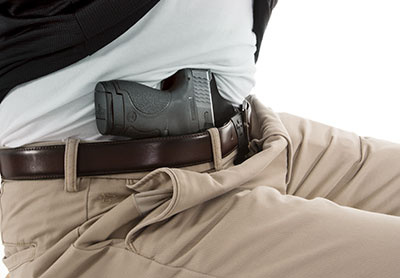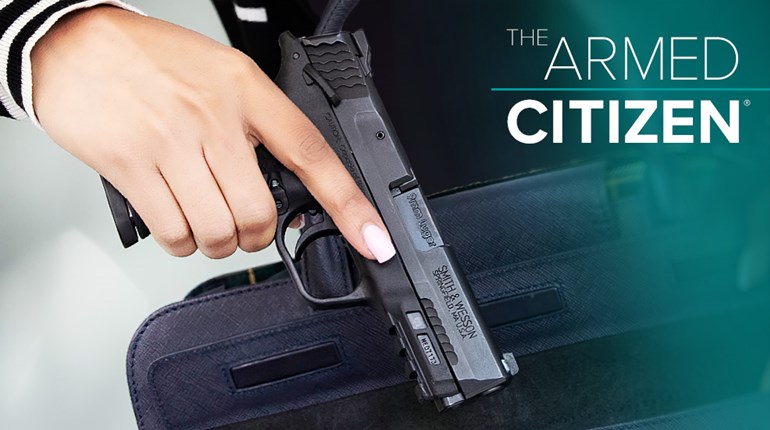
If you pay even the smallest amount of attention to trends in concealed carry, you’ll know that right now, appendix carry is one of the hottest. For those of you who don’t know, or perhaps are trapped in 1989, appendix carry is where you position your carry gun in the region of your appendix; essentially down the front of your pants. There are tremendous advantages to this carry position, there are some disadvantages and there are quite a few myths, rumors, exaggerations and misunderstandings.

The first thing to establish is appendix inside-the-waistband carry, or AIWB, has been around for as long as we’ve been carrying guns. One has to look no further than drawings of pirates with flintlock pistols stuffed into their waistbands to see the genesis of this method of carry. It’s a perfectly logical place to put a weapon, because our arms naturally hang in that region and it allows quick access to whatever object you’re carrying at that position.
AIWB was largely out of vogue with serious shooters for some time. The Modern Technique emphasized the 3- to 4-o’clock position of the gun, whether you used an inside-the-waistband holster or an outside-the-waistband holster. This remained the status quo for ages, until quite recently, when people began to seriously experiment with, write about and train with appendix carry. In fact, you can credit the resurgence of AIWB to the Internet, as it allowed like-minded shooters to find each other and spread the ideas, tips and tricks necessary to successfully utilize this carry position.
Of course, it’s still a hotly debated topic, because where you choose to carry your gun is a very personal choice. Like everything, there are pros and cons with appendix carry. For a number of reasons, the debate over AIWB is particularly passionate on both sides. This could be attributed to the sensitive nature of the anatomical area where the gun is carried if you’re male, which leads to the first myth about AIWB.

You’ll shoot your…
This is often the first thing you hear out of AIWB detractors when you tell them how you carry your gun. The thinking is this carry position is inherently dangerous because the barrel of the gun is pointed at your wedding tackle if you’re male. That’s why we’re addressing this first, because everyone thinks this. Of course, the truth has both good news and bad news.
The good news is that if you’re carrying AIWB in a good holster on a good belt, the muzzle of your gun probably isn’t pointed at your gentleman parts. The bad news is that in some positions, it’s pointed at your femoral artery instead. On the list of things that you don’t want to put a bullet into, your femoral artery is pretty high up there.
So right off the bat when discussing AIWB, we have to get this out there: a mistake when carrying AIWB can have dangerous consequences. However, smart training and good gear selection can minimize that risk to almost zero.

Gear selection
This part is a personal choice. There are some guns that are mechanically better suited for appendix carry than others. Generally speaking, the guns best suited for appendix carry are traditional DA/SA semi-auto pistols, and semi-automatic pistols with a manual safety. Also on the list are Glocks equipped with the Gadget Device, which allows the user to holster the pistol much like they would a DA/SA semi-auto.
The reason those pistols are preferable for AIWB is because the most dangerous part of carrying at this position is holstering. A DA/SA handgun allows you to place your thumb over the hammer and prevent the gun from firing if something should be caught in your trigger guard. The Gadget performs the same function on a Glock. A manual safety, such as the safeties on a 1911, prevent the gun from firing when it’s being placed back into the holster, as well.
One should never rely solely on mechanical safeties. The best way to stay safe while carrying AIWB is a combination of gear and training. Todd Green, one of the most vocal advocates for AIWB, advocated for two specific actions when holstering at the AIWB position. The first was a “hard break.” This means after shooting, bring the gun back to a retention position, and then intentionally “break” your mindset out of shooting mode and put it into “holster” mode. The idea is to make holstering an intentional act that you perform with the same care as when firing the gun. The second concerns leaning back a little bit as you holster, “looking” the gun into the holster and then pushing your hips forward. By doing this, you change the angle of where the muzzle is pointing during the process, and if done correctly, the gun will not be pointing at the femoral artery or, in the case of males, your genitals.

Advantages
Now that safety has been covered, let’s take a look at the advantages of AIWB. The first one that comes to mind is that it is faster to draw from than traditional IWB carry. Proponents of “junk carry,” as AIWB is often referred to online, point out that the natural arm position makes accessing the gun much quicker from the AIWB position than it is when reaching back and behind you. This is borne out when I tested the methods with a timer: When drawing with a T-shirt/closed concealment garment, AIWB was consistently .20 seconds faster to the first shot than regular IWB. Extremely talented shooters can achieve draws inside of 1 second using appendix carry while still getting accurate hits on target.

Another advantage to appendix carry is better handgun retention. In the traditional IWB position, your gun is either beside or behind you, and thus more vulnerable to a gun grab. While that’s a rather statistically unlikely proposition, moving the gun to the AIWB position puts it directly in front of you, which is the direction from which humans are designed to best detect and fight threats.
Speed of access and better retention/security are two great reasons to carry AIWB. There are quite a few smaller ones, as well. Many people, myself included, find it easier to conceal a full-size gun AIWB than at the traditional position. If you fall backward, you won’t land on your gun and bruise your kidneys. Little things like that.

Disadvantages
Other than the aforementioned safety issue, there are some disadvantages to AIWB carry. The first is comfort, which requires a bit of delicate explaining. Junk carry works best if your personal definition of “in shape” is not “round is a shape.” Because of that, certain body types will experience discomfort when performing normal activities like sitting, driving or tying your shoes. It is worth noting that much of the discomfort can be mitigated or eliminated entirely with good holster and belt selection.
Discomfort and the potential safety risks are, to my perception, the only real disadvantages. They are also outweighed by the advantages in concealment, ease of access and retention.
The most important part of successfully carrying at the appendix position is holster selection. I personally went through five different holsters before I finally found the one that was the right choice for my body, gun and carry position. You may very well have to try quite a few holsters—and you might have to re-think your choice of firearm—but when you get it right, the results are worth it.
If you’re thinking about trying to go armed using appendix carry, remember to take it slow. As we’ve established, there are huge advantages to the method. But, don’t just jump in the deep end. Try several holsters. Practice carrying around the house with a blue gun or an unloaded pistol to get a feel for it. Learn how to holster safely at the appendix position. Be prepared to buy quite a few holsters. Once you’ve done that, start training via dry-fire and on the range. Then you’ll really start to see the benefits of what is quite likely the world’s oldest carry position.

Blackhawk A.R.C. IWB Holster
Blackhawk’s new A.R.C. (Appendix Reversible Carry) is an Inside-the-waistband holster injection-molded from a firm-yet-flexible, lightweight polymer. It is fully ambidextrous, permitting either right- or left-hand use. Retention pressure, cant and ride height are adjustable, and clips for 1.5- and 1.75-inch belts are included. MSRP: $22.45; blackhawk.com
—Daniel T. McElrath




































